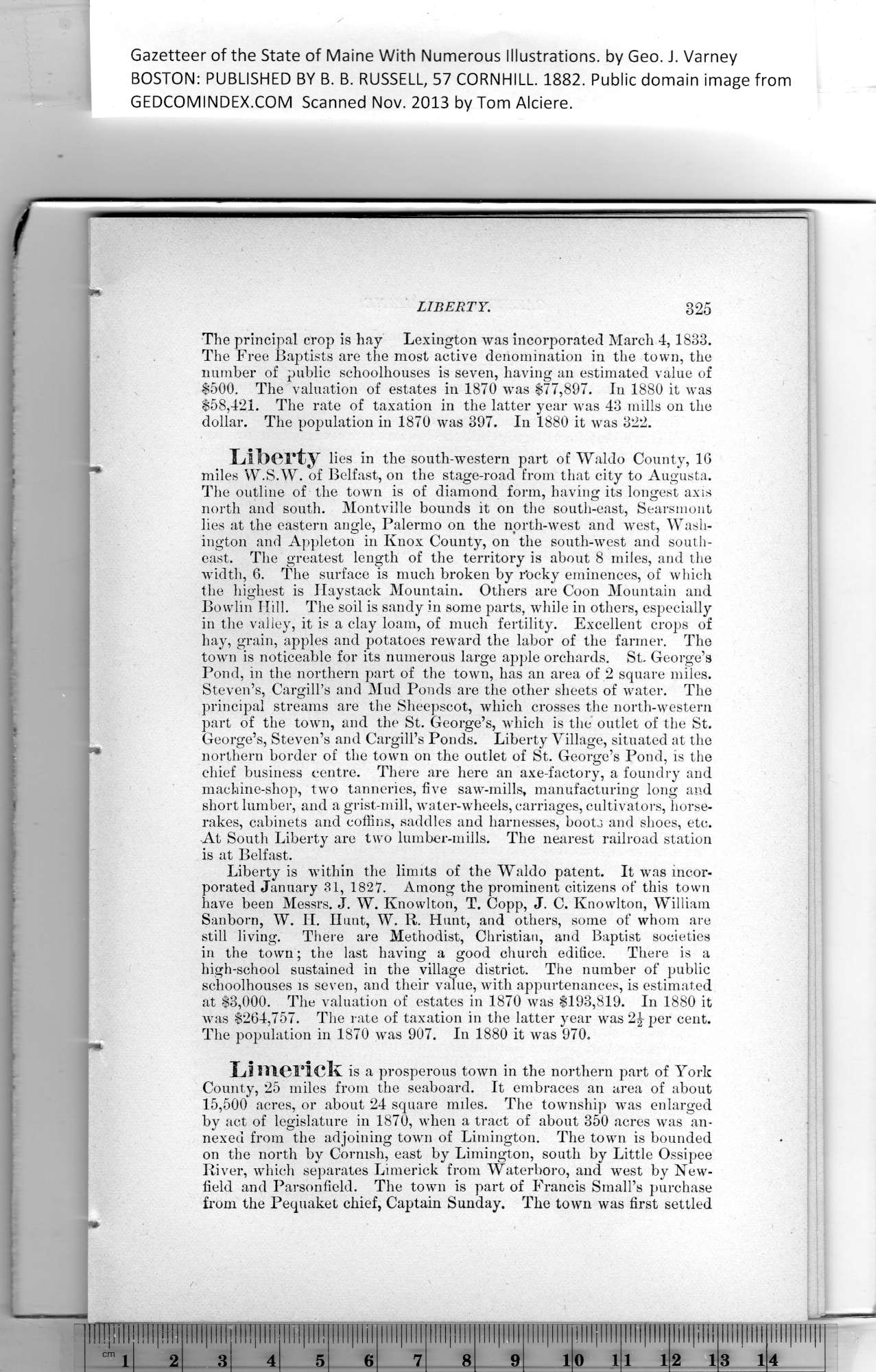|
Gazetteer of the State of Maine With Numerous Illustrations, by Geo. J. Varney
BOSTON: PUBLISHED BY B. B. RUSSELL, 57 CORNHILL. 1882. Public domain image from
LIBERTY. 325
The principal crop is hay Lexington was incorporated March 4,1833.
The Free Baptists are the most active denomination in the town, the
number of public schoolhouses is seven, having an estimated value of
$500. The valuation of estates in 1870 was $77,897. In 1880 it was
$58,421. The rate of taxation in the latter year was 43 mills on the
dollar. The population in 1870 was 397. In 1880 it was 322.
Liberty lies in the south-western part of Waldo County, 16
miles W.S.W. of Belfast, on the stage-road from that city to Augusta.
The outline of the town is of diamond form, having its longest axis
north and south. Montville bounds it on the south-east, Searsmont
lies at the eastern angle, Palermo on the north-west and west, Wash-
ington and Appleton in Knox County, on the south-west and south-
east. The greatest length of the territory is about 8 miles, and the
width, 6. The surface is much broken by r'ocky eminences, of which
the highest is Haystack Mountain. Others are Coon Mountain and
Bowlin Hill. The soil is sandy in some parts, while in others, especially
in the valley, it is a clay loam, of much fertility. Excellent crops of
hay, grain, apples and potatoes reward the labor of the farmer. The
town is noticeable for its numerous large apple orchards. St. George’s
Pond, in the northern part of the town, has an area of 2 square miles.
Steven’s, Cargill’s and Mud Ponds are the other sheets of water. The
principal streams are the Sheepscot, which crosses the north-western
part of the town, and the St. George’s, which is the outlet of the St.
George’s, Steven’s and Cargill’s Ponds. Liberty Village, situated at the
northern border of the town on the outlet of St. George’s Pond, is the
chief business centre. There are here an axe-faetory, a foundry and
machine-shop, two tanneries, five saw-mills, manufacturing long and
short lumber, and a grist-mill, water-wheels, carriages, cultivators, horse-
rakes, cabinets and coffins, saddles and harnesses, boote and shoes, etc.
At South Liberty are two lumber-mills. The nearest railroad station
is at Belfast.
Liberty is within the limits of the Waldo patent. It was incor-
porated January 31, 1827. Among the prominent citizens of this town
have been Messrs. J. W. Knowlton, T. Copp, J. C. Knowlton, William
Sanborn, W. H. Hunt, W. R. Hunt, and others, some of whom are
still living. There are Methodist, Christian, and Baptist societies
in the town; the last having a good church edifice. There is a
high-school sustained in the village district. The number of public
schoolhouses is seven, and their value, with appurtenances, is estimated
at $3,000. The valuation of estates in 1870 was $193,819. In 1880 it
was $264,757. The rate of taxation in the latter year was 2|- per cent.
The population in 1870 was 907. In 1880 it was 970.
LimericK is a prosperous town in the northern part of York
County, 25 miles from the seaboard. It embraces an area of about
15,500 acres, or about 24 square miles. The township was enlarged
by act of legislature in 1870, when a tract of about 350 acres was an-
nexed from the adjoining town of Limington. The town is bounded
on the north by Cornish, east by Limington, south by Little Ossipee
River, which separates Limerick from Waterboro, and west by New-
field and Parsonfield. The town is part of Francis Small’s purchase
from the Pequaket chief, Captain Sunday. The town was first settled
PREVIOUS PAGE ... NEXT PAGE
This page was written in HTML using a program written in Python 3.2
|
